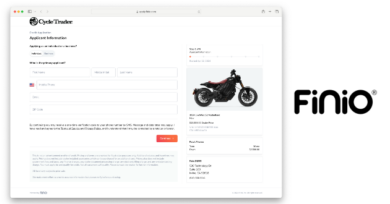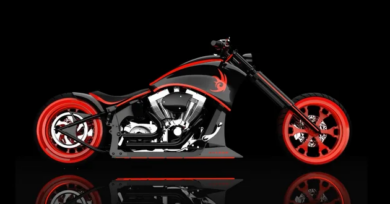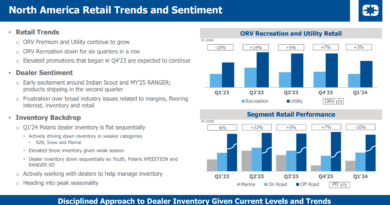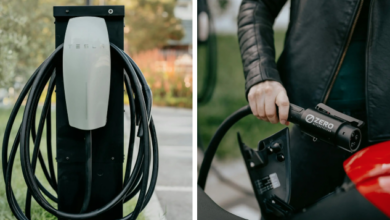Breaking the snow-less funk – January 22, 2007
Powersports retail consultant Jim Rasmus has several ideas of how to boost morale at a snowmobile dealership, but his favorite is this: hot dogs.
He preaches the gospel of Hot Dog Sundays to dealerships in a funk — or who want to enthuse their customer base.
“It’s the camaraderie affect,” he said. “This is the only industry where strangers will meet with other strangers at a store and talk about the products that they’ve bought. You don’t see that at Bass Pro, Cabela’s or at JC Penney’s.” What’s more, they’ll share information about their recent experiences and encourage each other to get out and use their snowmobiles, he said.
Snow-bare landscapes in otherwise normal snowmobile hotbeds — and for multiple years in some places — can place a damper on customer excitement and dealership attitude. The right techniques and special strategy can help lift the spirits, and sales, on and off the showroom floor.
The Power Of Positive Thinking
How does the snowmobile sales staff at Forest Lake Motorsports, Forest Lake, Minn., keep an upbeat attitude?
“We look forward to the boat show,” said salesman Rick Claugherty, with a chuckle. “Really, though, it’s tough. I’d be lying if I said anything else.”
Denny Johnson, owner of Ski-Doo dealership Kuyohoora Outdoor Center in Poland, N.Y., tries to keep a broad perspective on the current conditions. “I’ve been a dealer since 1968, and I’ve been through this all before,” he said, noting the gas crisis in the early 1970s and another no-snow winter in 1980.
As a weather-watcher, he also points out that the next Arctic blast over the open waters of the Great Lakes will dump plenty of snow in New York.
Keeping up customer morale isn’t easy, either.
“The customers are frustrated with no snow,” Claugherty said. “Very frustrated. We’d like to move the product.”
Moreover, he has noticed a change in customer attitude in the past six months. “At Haydays [in September], they were all pretty excited,” Claugherty said. The same customer in January is the opposite.
He calls sales sporadic. “It has been difficult, but I’ve sold a few. There’s the knowing that we will get snow, but it’s a question of when. For me, it’s just a matter of pointing out that you can trailer not too terribly far and get good conditions,” he said.
Rasmus, president of Rocklan, Calif.-based Retail Design Associates, said directing customers to snow is a good strategy. Dealers also can bring the outdoors — or at least the concept — into the dealership.
“I suggest getting that white batting to dress up the snowmobile displays,” he said. “Keep dressing up the mannequins and create signage that says, ‘think snow.’ And, especially important for the new customer, show the places they can go. If you let the store stay stagnant, it will always be stagnant.”
Johnson said he has used some of his downtime to play catch-up. The ceiling has a fresh coat of paint, as does the outside. They’re taking care of things that had been pushed aside during busy times, such as cleaning and organizing the inventory.
That’s good, said Rasmus, but dealers should continuously make the dealership look fresh.
He recommends changing displays weekly, whether it’s rearranging where the machines are on the showroom floor or creating mini-scenes. For example, he said, arrange a cluster of sleds with a mom, a dad and a teen selection to make a family atmosphere.
Strategy
When Plan A isn’t working, Rasmus said it’s time to force it to work.
“If there isn’t snow, you have to start thinking discount,” he said. “It’s a fact of life in retail.” Customers expect sale prices and clearance sales in January, and Rasmus said the powersports industry is one of the few that doesn’t comply with that model. It should, he said.
At this point, too, he said, an advertising plan has got to kick in — and it should be something that continues year-round, despite the seasonal nature of snowmobiling.
The bigger goal is to get rid of merchandise, he said. “And that includes units.”
“You can’t afford to carry product over,” he said. “Dealers will take snowmobile clothing that doesn’t sell, put it in a brown box and store it. It’s like putting your savings under a mattress. Then, when they take it out again, they still have to mark it down.”
Sales staff require a strategy, too.
Weekly sales meetings should keep staff apprised of sales promotions and ways to keep activity going. Rasmus recommends staff incentives, anything from a flat dollar amount to a percentage of profits — including on clothing and accessories.
“The stores that are not offering a spiff for jackets are losing the ability to get rid of merchandise,” he said.
Get Active
Johnson said he has heard just about every excuse from customers as to why they’re not buying this season.
“I bought a new machine last year and it’s covered with an inch of dust.”
“I’m not going to even bother to register my machine this year.”
“This will be the first year I have not bought something new, but I didn’t use my sled last year.”
With temperatures in the 60s, robins in the trees and people mowing lawns — all in early January — Johnson agrees it’s a tough snowmobile sales climate.
“Dealers here are screaming that there’s no money, and they can’t pay the bills,” he said. “They’re depressed, to say it mildly.”
Johnson is working hard to do something about it. While he can’t will it to snow, he said he can promote an event in an area likely to have snow and encourage customers to take part.
He said he tried to get something going earlier in the season with demo rides, on-trail guided rides and displays, but he said that he couldn’t find any factory reps or other dealers to buy-in.
“I couldn’t get their chins off the table,” he said of the dealers he approached. It was an equally hard sell to manufacturer sales reps.
Instead, he has lined himself up with a local group that is promoting a vintage snowmobile event. They’ve done the planning; Johnson is doing the promoting.
It’s not the new models that he originally had in mind, but he said it’s something that involves snowmobiles, snow and riding. It has been enough for some of his customers to get excited, he said, as well as himself. And this event has given his customers, staff and himself something to look forward to.
“Look at this, I have a vintage machine up on the table right now,” he said. “I’m changing radiators, the gearing, and it makes me happy to be doing something.”
Backup Plans
Both dealerships have a backup plan that will likely pull them through the tough year.
For Forest Lake Motorsports, it’s the marine division. The dealership sold about 500 snowmobile units in the 1990s, but has gradually shifted toward boats as its primary product. Claugherty said he expects to turn between 20 and 40 snowmobile units.
At Kuyohoora, it’s Internet sales that will keep them afloat. At its peak, the dealership sold 600 units. So far this season, Johnson hasn’t even sold 20.
He anticipated slow sales, especially due to the number of non-current machines in his area, so he cut down his order.
Instead, he has started on a generator refurbishing business and has put a greater focus on his Internet sales. “It’s our saving grace,” he said of e-commerce. “It has been a steep learning curve, but it’s what keeps us going and going well.”
Johnson sells non-current Ski-Doo outerwear, and hopes to expand into accessories.
Overall Internet sales have dropped since the holidays, but he said sales were extremely good up until then. He estimates year-over-year Internet sales are down by about 10 percent. He said his Midwest online sales account for about 40 percent of sales, particularly in the areas hit by the snowstorms.




